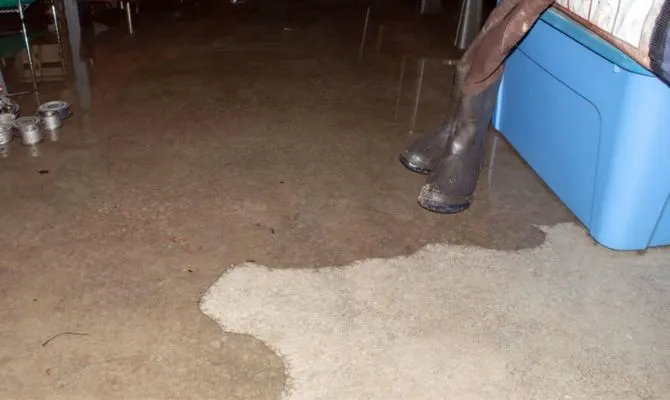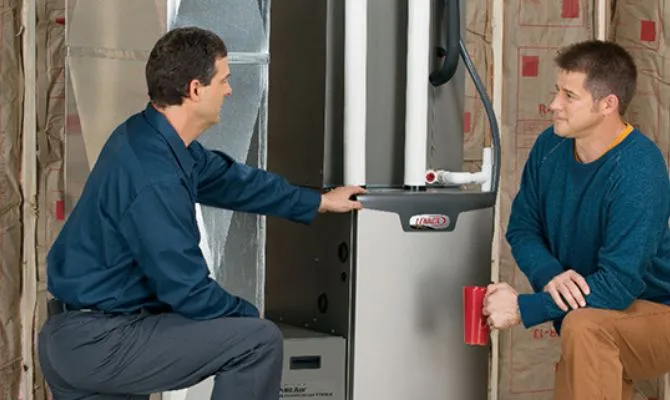Water damage is a common household issue that can be caused by a variety of factors, one of which is a leaking furnace. A leak from your furnace can lead to high repair costs, mold growth, and even the need to replace the furnace. It is important to address furnace leaks as soon as they occur in order to avoid these issues.
When a furnace leaks, it is typically due to a problem with the condensation drain or the heat exchanger. The condensation drain is responsible for removing any excess water that is produced during the heating process, and if it becomes clogged or damaged, it can lead to a leak. The heat exchanger is also a common source of leaks, as it can develop cracks or corrosion over time.
To prevent furnace leaks, it’s important to schedule regular maintenance and inspections to ensure that the condensation drain and heat exchanger are in good working condition. Additionally, it’s important to address any leaks as soon as they are noticed to prevent further damage. If you suspect that your furnace is leaking, it’s best to call a professional to diagnose and fix the problem. Don’t wait, call now to prevent the problem from getting worse.
Why Is My High Efficiency Condensing Furnace Leaking Water?
Conventional or standard efficiency furnaces do not produce water as a byproduct of the heating process. However, high efficiency furnaces, which have an efficiency rating of 90% or higher, do produce condensation due to the presence of a secondary heat exchanger. This is why high efficiency furnaces are also known as condensing furnaces, while standard efficiency furnaces are referred to as non-condensing furnaces.
The primary heat exchanger is the first component in a furnace where the burning gas exchanges heat with the surrounding air. The exhaust or flue gas then moves on to the secondary heat exchanger. This is where the exhaust gas undergoes further heat exchange, causing water vapor to form.
The secondary heat exchanger is an important component in a high efficiency furnace because it allows for additional heat recovery. The exhaust or flue gasses that exit the primary heat exchanger still contain a significant amount of heat energy. By passing these gasses through the secondary heat exchanger, the furnace is able to capture more of this heat energy and use it to heat the surrounding air.
This process of capturing additional heat energy is what causes the formation of water vapor in a high efficiency furnace. As the exhaust gasses pass through the secondary heat exchanger, they cool down and the water vapor they contain condenses into liquid form. This release of heat energy into the secondary heat exchanger is what makes the furnace more efficient.
The condensation that forms is then drained away through a condensate pump or a floor drain. This is important to prevent water damage and maintain the furnace’s efficiency. The secondary heat exchanger is a crucial component in a high efficiency furnace, it increases the efficiency of the furnace by recovering more heat from the exhaust gasses and also it’s important to keep it in good working condition to prevent water damage.
Conventional Furnace Is Leaking Water
Water leakage from a conventional furnace can be caused by several reasons, but the most common causes are a malfunctioning built-in humidifier or an ill-fitted exhaust pipe. The humidifier, which is a device that adds moisture to the air, empties excess water through the furnace drain line. If the drain line becomes clogged, the water will accumulate and leak from the humidifier into the furnace. This can give the appearance that water is leaking from the furnace components when in fact, the humidifier is the challenged part.
To troubleshoot this issue, it’s important to inspect the water lines of the furnace humidifier for cracks or leaks. Check for any visible signs of damage such as pinholes, or any other visible signs of leakage. Additionally, ensure that the lines are properly connected to the humidifier as ill-fitted lines can easily create leaks. If the humidifier is not working correctly, and the water lines look fine, it could be a problem with the humidifier itself and it may need to be replaced.
If the humidifier appears to be functioning correctly, inspect the exhaust pipe. The exhaust pipe is responsible for expelling the combustion gases out of the house, and if it’s not properly fitted or loose, it can allow water to leak from the unit. It’s important to be cautious when examining the pipe as it can become dangerously hot. To avoid the possibility of injury, it’s best to contact a furnace expert to repair or replace the pipe.
How To Fix Condensation Leak in Furnace
The condensate pump is a key component of a high efficiency furnace that is responsible for removing the condensation that forms as a byproduct of the heating process. The condensation is typically drained into a condensate pump from the secondary heat exchanger and then pumped out of the furnace and into a drain or sewer.
However, if the condensate pump becomes clogged, it can prevent the condensation from draining properly. This can cause the condensation to back up and leak from the furnace, resulting in water damage. A blocked or partially blocked drain can also lead to water leakage from the furnace. If you notice water on the floor around your furnace unit, or water or rust stains within the cabinet, it’s likely that your furnace is not draining properly.
Similarly, a malfunctioning pump can also cause water to back up and create a leak. The pump could fail due to a number of reasons such as, electrical issues, mechanical issues, or lack of maintenance. In this case, a professional will have to replace it. Most condensate pumps have a lifespan of between 3-5 years, after which it may not function optimally. It’s important to keep an eye out for signs of a malfunctioning condensate pump and address it as soon as possible to prevent further damage or potential health hazards.
Water Leaking From AC Furnace
If you notice a puddle of water around your furnace, and it only seems to grow when the air conditioner is in use, the problem is likely with your air conditioner, not the furnace. When the air conditioner runs, it not only cools your home but also removes humidity from the air.
The air conditioner must release the moisture it has collected through the unit’s condensate drain line. If the drain line becomes clogged, forms a leak, or there’s a leak in the drain pan, the water will accumulate on the ground.
It’s important to note that the AC drain line is often located near or even on top of the furnace, so it’s easy to mistake the problem as a furnace leak when it’s actually an issue with the AC drain line.
However, if your air conditioner hasn’t been in use recently, the drain line isn’t the source of the leak. It’s best to call an HVAC professional to determine the cause of the leak and the best course of action.
How to Access Condensate Drain Pan
The drain pan is an essential component of an air conditioning unit that is designed to catch any condensate that forms during the cooling process. The condensate is a byproduct of the cooling process and it is typically a small amount of water that is created as the refrigerant inside the evaporator coil absorbs the heat from the air inside your home.
The primary drain pan is typically located under the evaporator coil, it’s a shallow metal pan that is designed to collect the condensate as it drains from the evaporator coil. Some AC units, particularly larger ones, have a secondary drain pan which is positioned under the unit itself. This pan serves as a backup in case the primary pan becomes full or clogged.
However, if there is a crack or hole in the primary or secondary drain pan, the excess water will leak out instead of being directed to the drain line, this can cause water damage or mold growth. It is important to keep an eye out for signs of a leaking drain pan and address it as soon as possible to prevent further damage or potential health hazards.
Can a Frozen Coil Cause a Leak?
If the evaporator coil of your air conditioning unit freezes, it can cause the unit to leak. The evaporator coil is an essential component of the AC unit that absorbs heat from the air inside your home. It contains refrigerant that evaporates as it absorbs heat and it is cooled by the refrigerant’s flow.
When the evaporator coil becomes too cold, the moisture in the air can freeze on the coil. As the ice builds up, it forms a barrier that prevents the refrigerant from absorbing heat effectively. This can cause the refrigerant to become too cold and cause it to freeze and form a thick layer of ice on the coil.
When the ice on the coil melts, it can cause water to leak out of the unit and onto the floor. If this happens, it’s important to turn off your AC unit immediately and call a professional to diagnose and fix the problem.
Is Furnace Leaking Water Dangerous?
Water damage can be destructive, and a leaking furnace is no exception. Though it may not pose an immediate risk to your safety, it can certainly impact your comfort and lead to costly outcomes if left untreated.
Here are some of the potential consequences of a leaky furnace:
- Rust can form on the furnace’s components, which decreases efficiency, leads to breakdowns, and requires repairs.
- The heat exchanger is particularly vulnerable to rust, which can cause holes and cracks that can lead to exposure to harmful gases like carbon monoxide.
- Water leaking inside the furnace can also damage the internal electrical components, causing the furnace to stop working altogether.
- Circuit control board, for example, is responsible for transmitting the signals needed to start the furnace’s heating procedure. If water leaks on to the circuit control board, it won’t be long before you need to replace it.
- Dampness and moisture can cause mold growth which can be harmful to your health and can cause respiratory issues.
- Water leakage can also cause damage to your flooring and furniture if not addressed in a timely manner.
- It can also cause damage to your electrical wiring, which can be potentially dangerous.
- It’s important to address a leaky furnace as soon as possible to prevent further damage and serious consequences. You may still have heat now, but that won’t last for long. It’s best to call for a furnace repair before things get worse



